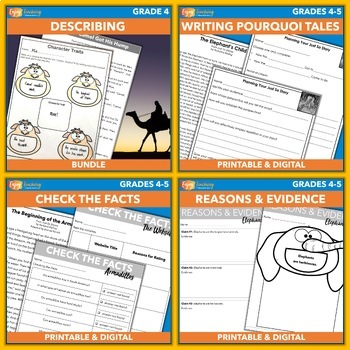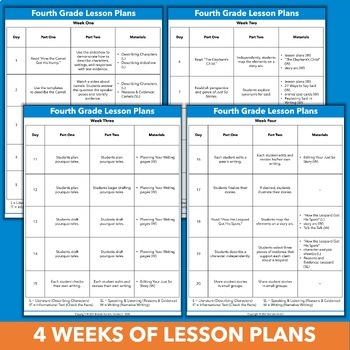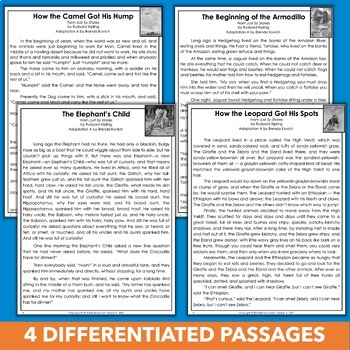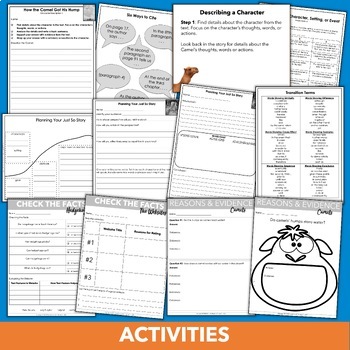Just So Stories ELA Unit for Fourth Grade – Reading and Writing Pourquoi Tales
- Zip
- Easel Activity
Products in this Bundle (8)
showing 1-5 of 8 products
Bonus
Description
This pourquoi tale unit has everything you need for four weeks of ELA instruction! Fourth grade students read differentiated Just So Stories; describe characters, settings, and events; write narratives; evaluate informational text; and identify claims and evidence in videos.
Open the previews to take a closer look.
Just So Stories
Four fanciful pourquoi, or origin, tales explain how an animal came to be or why it has certain traits. Each of the texts is included in its original form, as well as three differentiated versions that were specially adapted for upper elementary students.
- “How the Camel Got His Hump” (2-3 pages)
- “The Beginning of the Armadillo” (3-4 pages)
- “The Elephant’s Child” (3-7 pages)
- “How the Leopard Got His Spots” (2-5 pages)
Confidently teach kids to describe characters, settings, and events. This unit provides a slideshow (PowerPoint and Google Slides) to teach the processes, as well as differentiated templates to help them organize text evidence and construct responses.
Students check the accuracy of “The Beginning of the Armadillo” with information from multiple kid-friendly websites. Students answer questions and evaluate each site’s text features. As a culmination, they assess the accuracy of the story and rank the websites.
- Hedgehog – National Geographic Kids
- Tortoise – Easy Science for Kids
- Jaguar – San Diego Zoo Kids
- Armadillo – San Diego Zoo Kids
Kids use Just So Stories as mentor texts. Rudyard Kipling’s lively style encourages kids to experiment with word choice, repetition, and voices of the narrator and characters. After studying his work, fourth grade students plan and write their own.
Speaking and Listening Activities
In this activity, students watch videos about three animals from the stories: camels, armadillos, and elephants. As they watch, kids locate evidence and reasons that support speakers' claims. This gives students insight to informational structures used in speeches.
BONUS: Just So Stories eBook
To save paper, kids can access the stories as a website.
Lesson Plans
Need some help with unit planning? It’s already done for you! Grab the free set of four-week plans and get started. (Download the bonus preview on this page to get started right away.)
Your fourth grade students will love it – and you will too!
- The pourquoi tales are lively, and the activities are engaging.
- Opportunities for differentiation let you reach each you teach.
- You’ll hit important reading, informational text, writing, speaking and listening standards.
Enjoy teaching!
Brenda Kovich
Just So Stories was written by Rudyard Kipling. First published in 1902, it is now in the public domain.





